Dublin Core
Title
Ogg Farm/Bloddy Angle
Description
After breaking off the fighting of June 11, 1864, Confederate Gen. Wade Hampton's cavalry division withdrew to a position near here. Gen. Matthew C. Butler's South Carolinians spent the next morning preparing a stout defensive position along the bed of the Virginia Central Railroad. You are standing near the point of the L-shaped line Butler established to block Union Gen. Philip H. Sheridan's route to Gordonsville. A few yards from here, the apex of that line became known as the Bloody Angle during the heavy fighting later that day. Col. Richard H. Dulany's and Col. Gilbert J. Wright's brigades supported the South Carolinians and extended the line past the Ogg House and along the Charlottesville Road. The Danne Store and Gentry Farm occupied the narrow ridge to your front. Behind this narrow ridge was the staging area for numerous Union assaults on the Confederate line.
After spending the morning of June 12 destroying more than three miles of the Virginia Central Railroad and burning Trevilian Station, Gen. Alfred T. A. Torbert's Union cavalry division moved out toward Gordonsville about 2 P.M. The horse soldiers soon encountered Butler's strong defensive works, and Gen. George A. Custer's Wolverines deployed to attack them. The 1st Michigan, supported by the 7th Michigan, assaulted along the railroad tracks and was repulsed with heavy losses. They withdrew and were no factor in the rest of the day's fighting.
During the afternoon of June 12, 1864, Gen. Matthew C. Butler's fatigued South Carolinians repulsed seven separate attacks on the Bloody Angle by Gen. Wesley Merritt's and Col. Thomas C. Devin's dismounted troopers of Gen. Alfred T. A. Torbert's division. By the seventh attack, the main lines of battle lay only a few yards apart. Union artillerist Lt. Edward B. Williston's guns blasted away at the South Carolinians at pointblank range, a feat for which Williston later received the Medal of Honor.
Almost out of ammunition, Butler's men grimly hung on. In mid-afternoon, Gen. Fitzhugh Lee's division arrived in support after a lengthy flank march from Louisa Court House. Gen. Williams C. Wickham's brigade joined Butler while Gen. Lunsford L. Lomax's brigade went around the Union right flank about half a mile up the Gordonsville Road. As Merritt made the seventh Union attack, Lomax had his cavalrymen and a battery of artillery in position to strike the unsuspecting Torbert's flank.
Lomax launched his attack, supported by the rest of the Confederate force, shattering Torbert's lines and sending the Federals retreating toward the ruins of Trevilian Station. Left with no alternative and low on ammunition, Gen. Philip H. Sheridan broke off the battle and withdrew across the North Anna River that night, leaving Gen. Wade Hampton in possession of the battlefield. By defeating Sheridan, Hampton thwarted his plan to join Gen. David Hunter’s army and protected the Virginia Central Railroad, the link to the Shenandoah Valley, the "Breadbasket of the Confederacy."
After spending the morning of June 12 destroying more than three miles of the Virginia Central Railroad and burning Trevilian Station, Gen. Alfred T. A. Torbert's Union cavalry division moved out toward Gordonsville about 2 P.M. The horse soldiers soon encountered Butler's strong defensive works, and Gen. George A. Custer's Wolverines deployed to attack them. The 1st Michigan, supported by the 7th Michigan, assaulted along the railroad tracks and was repulsed with heavy losses. They withdrew and were no factor in the rest of the day's fighting.
During the afternoon of June 12, 1864, Gen. Matthew C. Butler's fatigued South Carolinians repulsed seven separate attacks on the Bloody Angle by Gen. Wesley Merritt's and Col. Thomas C. Devin's dismounted troopers of Gen. Alfred T. A. Torbert's division. By the seventh attack, the main lines of battle lay only a few yards apart. Union artillerist Lt. Edward B. Williston's guns blasted away at the South Carolinians at pointblank range, a feat for which Williston later received the Medal of Honor.
Almost out of ammunition, Butler's men grimly hung on. In mid-afternoon, Gen. Fitzhugh Lee's division arrived in support after a lengthy flank march from Louisa Court House. Gen. Williams C. Wickham's brigade joined Butler while Gen. Lunsford L. Lomax's brigade went around the Union right flank about half a mile up the Gordonsville Road. As Merritt made the seventh Union attack, Lomax had his cavalrymen and a battery of artillery in position to strike the unsuspecting Torbert's flank.
Lomax launched his attack, supported by the rest of the Confederate force, shattering Torbert's lines and sending the Federals retreating toward the ruins of Trevilian Station. Left with no alternative and low on ammunition, Gen. Philip H. Sheridan broke off the battle and withdrew across the North Anna River that night, leaving Gen. Wade Hampton in possession of the battlefield. By defeating Sheridan, Hampton thwarted his plan to join Gen. David Hunter’s army and protected the Virginia Central Railroad, the link to the Shenandoah Valley, the "Breadbasket of the Confederacy."
